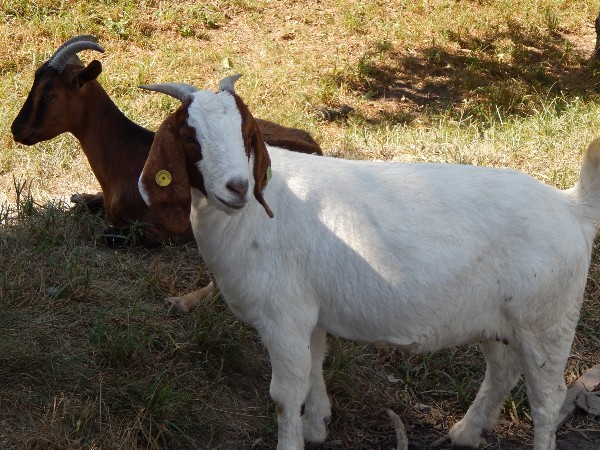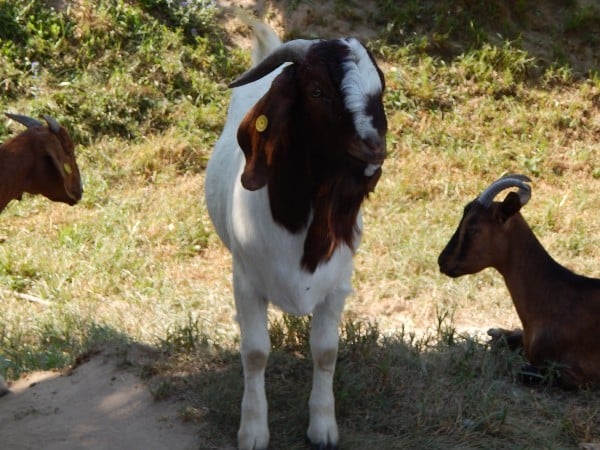Goat fattening techniques, ideas, and tips
Today, we discuss the topic of goat fattening methods, techniques.
What is fattening? (Finishing) Intensive feeding of highly nutritious feed to support fast growth and fat deposition to achieve desired carcass quality. This targets the local market that has a very high demand for fat animals. The operation of large feedlots by export slaughterhouses and independent feedlot operators or on-farm feedlots is becoming feasible. The principal functions of such feedlot operations are to assemble large numbers of goats, often coming from different genetic and management backgrounds, and make a product of acceptable standard. What is goat fattening? Goat fattening is nothing but” intensive feeding of goats in feedlots to slaughter weight with an adequate finish or fat deposit”.
Advantages of goat fattening
Fattening is a strategic feeding choice. Advantages of goat fattening will be given below;
- Technically, it is quite simple and within the capabilities of small farmers to execute; moreover, the results are highly visible. This helps farmers to have confidence in the system. Other techniques, such as feeding to boost reproductive performance, are less convincing because the farmer can be unsure that the extra feed resulted in any benefit.
- Benefits can be understood within a short period of time, unlike other animal production activities.
- Goat fattening generates cash income that is eagerly sought by farmers.
- Goat fattening is generally profitable because of the value per kilogram of live weight increases as both weight and condition increase.

Read: Crab Training in India.
Weight gain for goats:
How do you fatten up a goat? Grains are the quickest, easiest approach to fatten up a goat because of the high carbohydrate content, but according to goat expert Susan Schoenian, your goat must receive no more than 1 1/2 pounds of grain per day. Goats must be fed grains out of a trough or hand-fed. The food must not be sprinkled on the ground.
The goat should feed daily in a field or in a pasture. Eating grass, plants, and bugs are beneficial and one of the most “natural” ways for a goat to eat. It’s very inexpensive for you.
The vitamins and minerals you give your goat with will vary based on the levels of carbohydrates, fats, and protein you decide to feed your goat. Vitamins and minerals can be purchased especially for goats at most feed stores. Calcium is perhaps the main popular mineral for goats, but phosphorus, magnesium, selenium, iron, and copper are just as important and must not be overlooked.
The protein is very important because it helps your goat build muscle, and it also aids in the proper levels of carbohydrate digestions. When protein is lacking in a goat’s diet, the carbohydrates will digest quickly, decreasing your goat’s energy and affecting the absorption of minerals.
Water your goats:
Supplying water for goats is especially important in goats that are pregnant or lactating, as well as for goats that live in a dry area. Most of the time, goats are capable to have their water needs met by eating plenty of lush grasses and plants. If you are concerned about goat water needs and do not have a pond or lake nearby, a water trough could be a wise investment for your goats.
Housing:
- Build a goat house with either bamboo or mud with a thatched roof. Space required must be 2 sq. m. per animal. House must be open on one side. Walls up to 1.2 m on the other three, with a gap of 0.5 to 0.8 m between the walls and roof, to supply sufficient ventilation without drought.
- Housing could be on the raised floor ready of bamboo with the thatched roof covering midway into the pens on both sides.
- Leguminous fodder trees must be planted around the edges of the paddock to form solid fencing and browse plants for all goats. Slatted bamboo or barbed wires can be used for whole the fencing.
Selection of goat for fattening:
Selection of good quality goats is very important if you are planning for goat fattening.
- Select goats that are good health without any physical defects.
- Select goats with medium body condition scores of 2.0 – 2.5
- Avoid emaciated (thin or weak, due to illness or a lack of food) goats as they often get a long time to recover.
- Selected goats must have a large skeletal frame.
- Select goat breeds with an improved potential for growth and fattening.
- Select goats with weights ranging from 20 kg to 25 kg for better fattening.
- Avoid goats that are too old as they are not appropriate for the fattening process and no demand in the local market.
- It is better to select goats between two and four years of age for the fattening process.
Breed:
Identify goat breeds with the greatest potential for growth and fattening. Early maturing breeds start depositing fat at an earlier age and can be prepared for the market at a lower weight. They want a shorter feeding period to reach a good carcass finish, although their growth rates are relatively lower. Late maturing types can make market readiness at a higher weight. In general, lowland goats mature late compared with highland animals. Hence, lowland animals are chosen for the production of fattened animals at a higher weight.

Read: How To Care Layer Birds.
Weight of animals:
Weight of animals at the begin of the feeding operation governs the duration of feeding and the types and amounts of feedstuffs needed. Lightweight that means 15-20 kg animals are more desirable for conditioning based on a larger proportion of roughage. Heavier lambs (>25 kg) want more concentrate and perform best in a shorter feeding period where high concentrate diets are used. It is, therefore, best to use sheep and goats with weights ranging from 20 to 25 kg from the fattening operation to take advantage of the two situations.
Age:
Animals can be placed on intensive feeding at any age, generally after weaning. Avoid goats that are too old. Check that the goat teeth are sound. This has implications on goat feed utilization. It is advisable to select goats between 2 and 4 years of age for fattening.
Feeding requirements:
The goat is not able to digest the cell walls of plants as well as the cow because feed stays in its rumen for a shorter time phase. A distinction as to what is meant by “poor quality roughage” is essential in order to make decisions concerning which animal can best utilize particular forage. This is so because goats avoid eating the stems, don’t mind the taste, have the capability to detoxify tannins and benefit from the relatively high levels of protein and cell soluble found in the leaves of these plants. On the other hand, straw, which is of reduced quality due to the high cell wall and low protein, can be used by cattle, but will not give even maintenance needs for goats because don’t utilize the cell wall as efficiently as cattle.
In addition, goats should consume a higher quality diet than cattle because their digestive tract size is smaller with regard to their maintenance energy needs. Relative to their body weight, the amount of feed wanted by meat goats is approximately twice that of cattle.
When the density of high-quality forage is low and the stocking rate is low, goats will still do well because their grazing or browsing behavior allows them to select only the highest quality forage from that on offer. Thus, they are able to do well in these situations, even though their nutrient requirements exceed those of most domesticated ruminant species. How to gain weight for goats? Feed your goats grain, that is corn or oats, out of a trough or bucket. Due to the high carbohydrate substance, the grain is the quickest method to increase weight gain in goats. Start feeding a quarter-pound of grain to each goat per day, and then gradually increase the amount.
Give a vitamin and mineral supplement that includes calcium, phosphorus, magnesium, selenium, iron, and copper. You can either add feed it to the grain or in a free-choice mineral block.
Feed goats protein to help build muscle and aid digestion. Complete supplements are obtainable that include protein, vitamins, and minerals. A minimum of seven percent crude protein is necessary for meat goats; lower protein levels will decrease forage consumption, causing goats to lose weight.
Fattening systems
Intensive feeding of goats before slaughter can be categorized into two systems:
Traditional systems:
These systems normally depend on grazing natural or planted pastures with variable degrees of supplementation. Animals want long periods of time to attain market weight and condition and often experience large fluctuations in the weight and condition depending upon feed availability. The conditioned animals can enter finishing operations targeted to supply local markets. Several better traditional systems are in use, but they are not widespread. Traditional systems can be better to supply animals of acceptable condition to slaughterhouses for ultimate export.
Agro-industrial byproduct-based fattening:
Fattening of goat based on agro-industrial by-products. This organism can be promoted to similar areas where agro-industrial by-products are available. Protein sources like oilseed cakes can be purchased from nearby processing plants and forage legumes can be grown in the area.
Record keeping in goat fattening:
- Though it is not very important for small goat farmers to keep the records, it is a good practice and could be referenced and useful for future goat farming.
- Keep health records including morbidity, symptoms, mortality, diagnosis, and treatments.
- Maintain growth or weight records including body condition scores.
- Maintain feed consumption in detail.
- It is better to maintain a financial record which includes all expenses, profits, and receipts.
Read: Ideas for Summer Gardening.
i could understand goat fattening techniques i will start thanks
for the next inform how to feed agoat/kg
Hi my name is Gemeda from Ethiopia i just started and bought over 40 goat and lost 20 goat already any advice pls
I am I am interesting for starting goat fatting businesses I need support about fatting technique
Nice article
I want to make next in the fattening cattle an goats an work in with other people who have experience an some structure I can buy all the animals
Thank you for a quality information